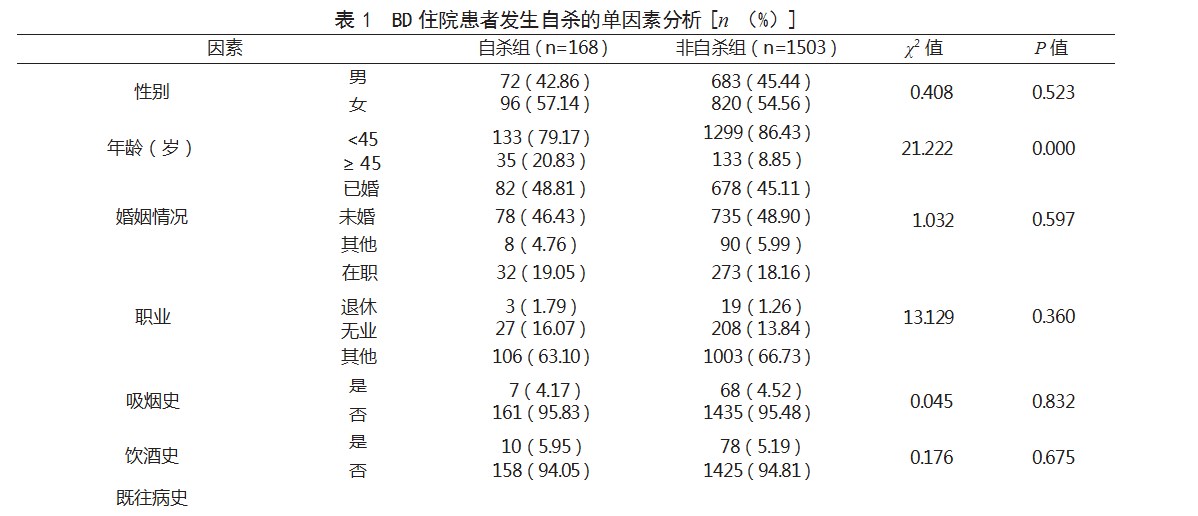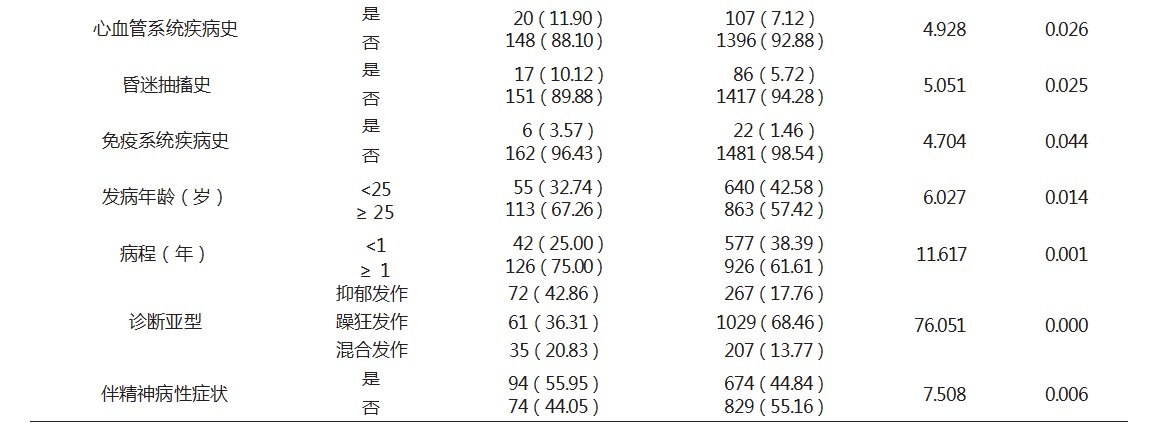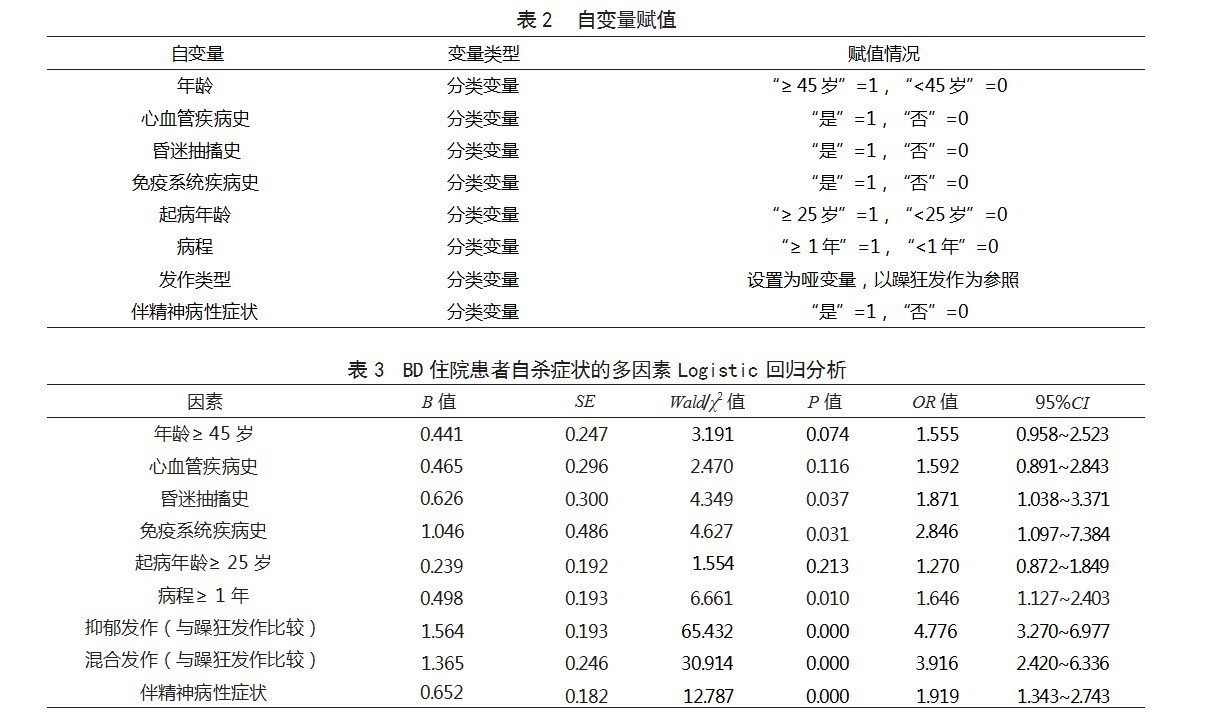双相情感障碍住院患者发生自杀的影响因素分析论文
2023-12-25 10:13:45 来源: 作者:xieshijia
摘要:目的:分析双相情感障碍(BD)住院患者发生自杀的影响因素。方法:回顾性分析2014年1月至2017年12月首都医科大学附属北京安定医院收治的1671例BD住院患者的临床资料。统计住院BD住院患者发生自杀的情况,采用Logistic回归分析BD住院患者发生自杀的影响因素。结果:1671例BD住院患者发生自杀168例,占10.05%(168/1671),设为自杀组,其余设为非自杀组;自杀组年龄≥45岁、既往心血管疾病史、昏迷抽搐史、免疫系统疾病史、发病年龄≥25岁、病程≥1年、抑郁发作、混合发作、伴有精神病性
【摘要】目的:分析双相情感障碍(BD)住院患者发生自杀的影响因素。方法:回顾性分析2014年1月至2017年12月首都医科大学附属北京安定医院收治的1671例BD住院患者的临床资料。统计住院BD住院患者发生自杀的情况,采用Logistic回归分析BD住院患者发生自杀的影响因素。结果:1671例BD住院患者发生自杀168例,占10.05%(168/1671),设为自杀组,其余设为非自杀组;自杀组年龄≥45岁、既往心血管疾病史、昏迷抽搐史、免疫系统疾病史、发病年龄≥25岁、病程≥1年、抑郁发作、混合发作、伴有精神病性症状占比均高于非自杀组,差异有统计学意义(P<0.05);经Logistic回归分析结果显示,昏迷抽搐史、免疫系统疾病史、病程≥1年、抑郁发作、混合发作、伴精神病性症状均为影响住院双相障碍患者发生自杀的危险因素(OR>1,P<0.05)。结论:昏迷抽搐史、免疫系统疾病史、病程≥1年、抑郁发作、混合发作、伴精神病性症状均为影响双相情感障碍住院患者发生自杀的危险因素。
【关键词】双相情感障碍;住院患者;自杀;影响因素
Analysis of influencing factors of suicide in inpatients with bipolar disorder
LI Yanru1,2,ZHAO Xin1,2,WU Han1,2,WANG Wen1,2,JIN Wenqing1,2,LUO Jiong1,2,JIANG Wei1,2,REN Yanping1,2*,FU Haibo3(1.Beijing Anding Hospital of Capital Medical University,National Clinical Research Center for Mental Disorders,Beijing Key Laboratory
of Diagnosis and Treatment of Mental Disorders,Beijing Non-convulsive Electroconvulsive Therapy Center,Beijing 100088,China;
2.Advanced Innovation Center for Human Brain Protection.Beijing 100069,China;
3.School of HealthSciences,Faculty of Biology,Medicine and Health,The University of Manchester,Manchester M13 9PL,UK)
【Abstract】Objective:To analyze influencing factors of suicide in inpatients with bipolar disorder(BD).Methods:The clinical data of 1671 inpatients with BD admitted to Beijing Anding hospital of capital medical university from January 2014 to December 2017 were retrospectively analyzed.The suicides in the BD inpatients were statistically analyzed.Logistic regression was used to analyze the influencing factors of suicide in the BD inpatients.Results:There were 168 cases of suicide in the 1671 BD inpatients,accounting for 10.05%(168/1671),which were set as suicide group,and the rest were set as non-suicide group.The proportions of the patients with age≥45 years old,history of cardiovascular disease,history of coma and convulsion,history of immune system disease,age of onset≥25 years old,course of disease≥1 year,depressive episode,mixed episode and combined psychotic symptoms in the suicide group were higher than those in the non-suicide group,and the differences were statistically significant(P<0.05).The Logistic regression analysis showed that history of coma and convulsions,history of immune system diseases,course of disease≥1 year,depressive episode,mixed episode,and combined psychiatric symptoms were all risk factors for suicide in the inpatients with bipolar disorder(OR>1,P<0.05).Conclusions:History of coma and convulsion,history of immune system disease,course of disease≥1 year,depressive episode,mixed episode and combined psychotic symptoms are the risk factors for suicide in the inpatients with bipolar disorder.
【Keywords】Bipolar disorder;Inpatient;Suicide;Influencing factor
双相情感障碍(BD)是一种既有躁狂症发作、又有抑郁症发作(典型特征)的常见精神障碍,自杀是BD患者抑郁发作期的常见症状,成人BD患者终生自杀率为4%~19%,是患者死亡的主要原因之一[1-2]。与门诊患者相比,住院患者症状较重且复杂,是发生自杀的高危人群,关注BD患者自杀相关影响因素,并采取及时有效的干预措施尤为关键[3]。本文分析BD住院患者自杀行为的影响因素。
1资料与方法
1.1一般资料回顾性分析2014年1月至2017年12月首都医科大学附属北京安定医院收治的1671例BD住院患者的临床资料。纳入标准:符合国际疾病分类标准第10版(ICD-10)中BD相关诊断标准[4];发病年龄≥18岁;研究期间首次因精神疾病住院且临床资料完整。排除标准:存在物质滥用或依赖;器质性、躯体疾病所致的精神障碍。患者家属对本研究内容了解并自愿签署知情同意书,且研究获首都医科大学附属北京安定医院伦理委员会批准(伦理审批号:2019-科研-90号)。其中男755例,女916例;年龄19~60岁,平均(31.52±10.3)岁。
1.2方法从电子病历系统收集患者的社会人口学资料及临床特征资料,包括性别、年龄、吸烟史、饮酒史、既往史、病程、发病年龄、临床症状及特征、自杀意念或行为、是否伴有精神病性症状等。
自杀评估由课题组一名具有高级职称的精神科医生根据病历记录资料评估,自杀意念或行为定义为患者一生中产生的任何自杀意念或自杀企图,自杀意念的定义为希望死亡的想法,自杀企图为具有一定程度死亡意图的自残行为,不包括没有自杀意图的自残[5]。
1.3观察指标(1)统计BD住院患者发生自杀的情况。(2)BD住院患者发生自杀的单因素分析。(3)采用Logistic回归分析BD住院患者发生自杀的影响因素。
1.4统计学方法采用SPSS 20.0统计软件处理数据,计量资料以(±s)表示,比较采用t检验,计数资料以率(%)表示,采用χ2检验,多因素分析采用Logistic回归分析,以P<0.05为差异有统计学意义。
2结果
2.1 BD住院患者发生自杀情况1671例BD住院患者发生自杀168例,占10.05%(168/1671),设为自杀组,其余设为非自杀组。
2.2 BD住院患者发生自杀的单因素分析两组性别、婚姻情况、职业、吸烟史、饮酒史比较,差异均无统计学意义(P>0.05);自杀组年龄≥45岁、既往心血管疾病史、昏迷抽搐史、免疫系统疾病史、发病年龄≥25岁、病程≥1年、抑郁发作、混合发作、伴有精神病性症状占比均高于非自杀组,差异有统计学意义(P<0.05)。见表1。


2.3 BD患者发生自杀的影响因素分析以自杀作为因变量(“自杀”=1,“非自杀”=0),将表1中P<0.05的变量作为自变量,并赋值说明,见表2。经Logistic回归分析结果显示,昏迷抽搐史、免疫系统疾病史、病程≥1年、抑郁发作、混合发作、伴精神病性症状均为影响BD住院患者发生自杀的危险因素(OR>1,P<0.05)。见表3。

3讨论
自杀是BD患者的常见症状,本研究结果显示,1671例BD住院患者发生自杀168例,占10.05%(168/1671),这一结果与文献报道结果相符[6]。提示住院BD患者发生自杀的风险较高,应做好自杀风险预防措施。
本研究经Logistic回归分析结果显示,昏迷抽搐史、免疫系统疾病史、病程≥1年、抑郁发作、混合发作、伴精神病性症状均为影响BD住院患者发生自杀的危险因素。分析原因:(1)昏迷抽搐史。昏迷抽搐与既往脑部疾病的发生有关,有创伤性脑损伤病史的个体自杀风险升高,可能与神经炎症过程有关[7]。(2)免疫系统疾病史。对于既往患有免疫系统疾病的患者,免疫系统疾病所致的炎症和氧化应激导致自杀的发生风险增高[8]。建议将昏迷抽搐史和免疫系统疾病史纳入自杀的风险评估中,加强监测。(3)病程≥1年。病程长与疾病反复发作可导致患者自杀风险增高[9]。建议应密切结合患者的社会人口学资料和临床状况,综合评估自杀风险,加强病程较长、年龄较大的BD患者的关注,预防自杀风险的发生。(4)抑郁发作、混合发作。住院BD患者抑郁发作、混合发作是自杀的危险因素[10],且长期使用抗抑郁药可能会诱发躁狂,或加重混合状态的激越行为,可导致自杀行为[11]。建议根据患者首次发作时的主要症状群为治疗方案提供参考,如首次发作时为抑郁建议使用抗抑郁药和(或)情感稳定剂,首次发作为躁狂时使用情感稳定剂和(或)抗精神病药[12]。(5)伴精神病性症状。伴有精神病性症状患者的主要症状为被害妄想、命令性幻听、关系妄想及自罪自责等,精神病性症状可使患者丧失判断能力,难以做出理性决策,导致行为冲动,故易发生自杀行为[13];且伴精神病性症状的抑郁症患者一般伴有重度焦虑和恐惧,自杀风险增高[14]。
综上所述,昏迷抽搐史、免疫系统疾病史、病程≥1年、抑郁发作、混合发作、伴精神病性症状均为影响BD住院患者发生自杀的危险因素。
参考文献
[1]Mcintyre RS,Berk M,Brietzke E,et al.Bipolar disorders[J].The Lancet,2020,396(10265):1841-1856.
[2]杨蕾,王中刚,张云,等.双相障碍患者自杀相关因素分析[J].国际精神病学杂志,2020.47(6):1148-1152.
[3]朱雪泉,冯媛,张玲.双相情感障碍门诊患者临床特征与自杀意念相关性研究[J].神经疾病与精神卫生,2021,21(8):552-557.
[4]范肖冬.ICD-10精神与行为障碍分类[M].人民卫生出版社,1993:45-52.
[5]Posner K,Brown GK,Stanley B,et al.The Columbia-Suicide Severity Rating Scale:initial validity and internal consistency findings from three multisite studies with adolescents and adults[J].Am J Psychiatry,2011,168(12):1266-1277
[6]Miller JN,Black DW.Bipolar Disorder and Suicide:a Review[J].Curr Psychiatry Rep,2020,22(2):6
[7]Wadhawan A,Stiller JW,Potocki E,et al.Traumatic Brain Injury and Suicidal Behavior:A Review[J].J Alzheimers Dis,2019,68(4):1339-1370.
[8]Vasupanrajit A,Jirakran K,Tunvirachaisakul C,et al.Suicide attempts are associated with activated immune-inflammatory,nitro-oxidative,and neurotoxic pathways:A systematic review and meta-analysis[J].J Affect Disord,2021,295:80-92.
[9]Li H,Huang Y,Wu F,et al.Prevalence and related factors of suicide attempts in first-episode and untreated Chinese Han outpatients with psychotic major depression[J].J Affect Disord,2020,270:108-113.
[10]Annear D,Agius M.Should Assessment for Bipolar Disorder and mixed affective state be a standard part of assessment for suicide risk[J].Psychiatr Danub,2016,28(Suppl-1):18-20.
[11]Gibbons RD,Brown CH,Hur K,et al.Relationship between antidepressants and suicide attempts:an analysis of the Veterans Health Administration data sets[J].Am J Psychiatry,2007,164(7):1044-1049.
[12]Pallaskorpi S,Suominen K,Rosenstr。m T,et al.Predominant polarity in bipolar I and II disorders:A five-year follow-up study[J].J Affect Disord,2019,246:806-813.
[13]Kuperberg M,Katz D,Greenebaum S,et al.Psychotic symptoms during bipolar depressive episodes and suicidal ideation[J].J Affect Disord,2021,282:1241-1246.
[14]Fredriksen KJ,Schoeyen HK,Johannessen JO,et al.Psychotic Depression and Suicidal Behavior[J].Psychiatry,2017,80(1):17-29.










